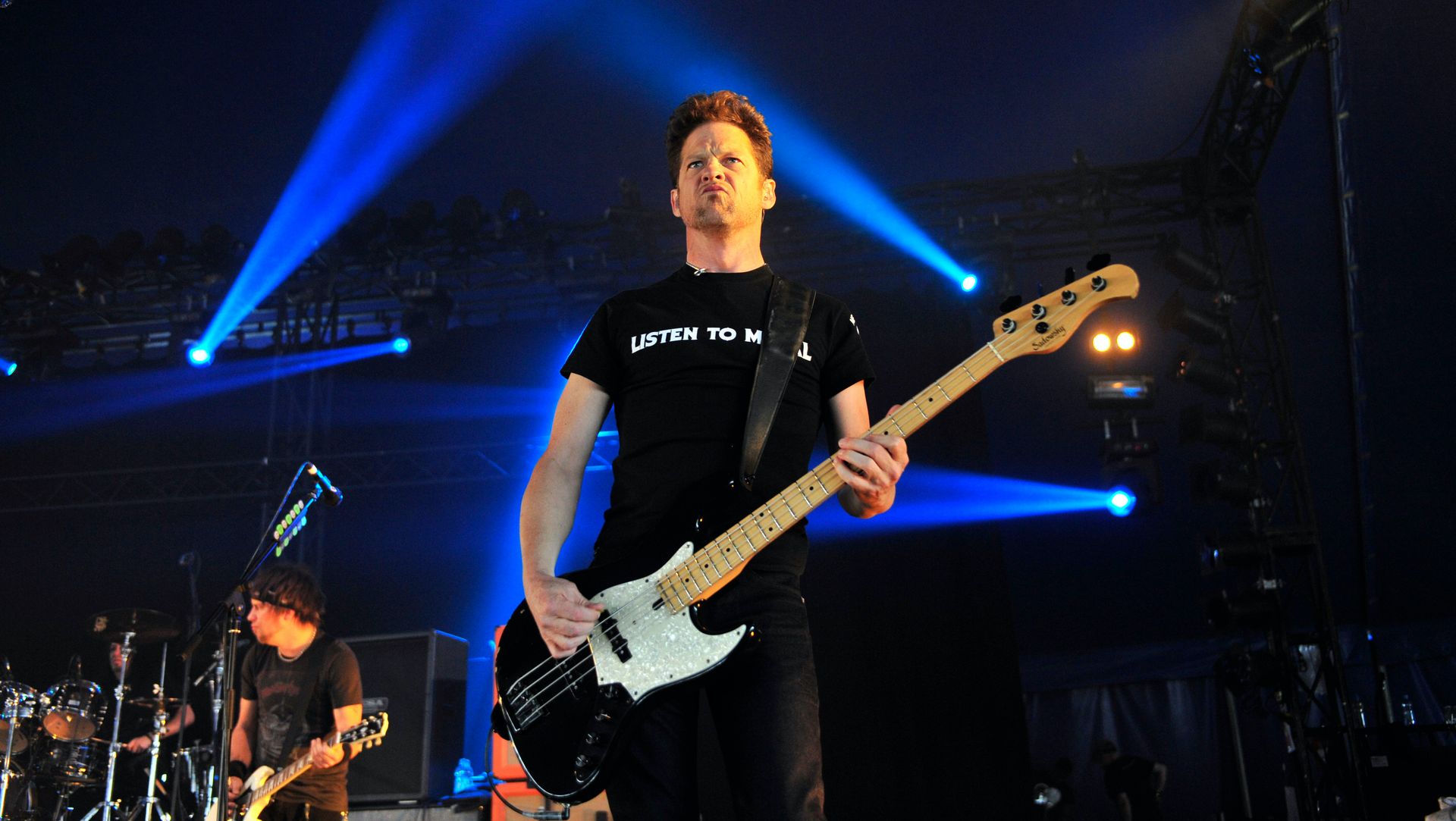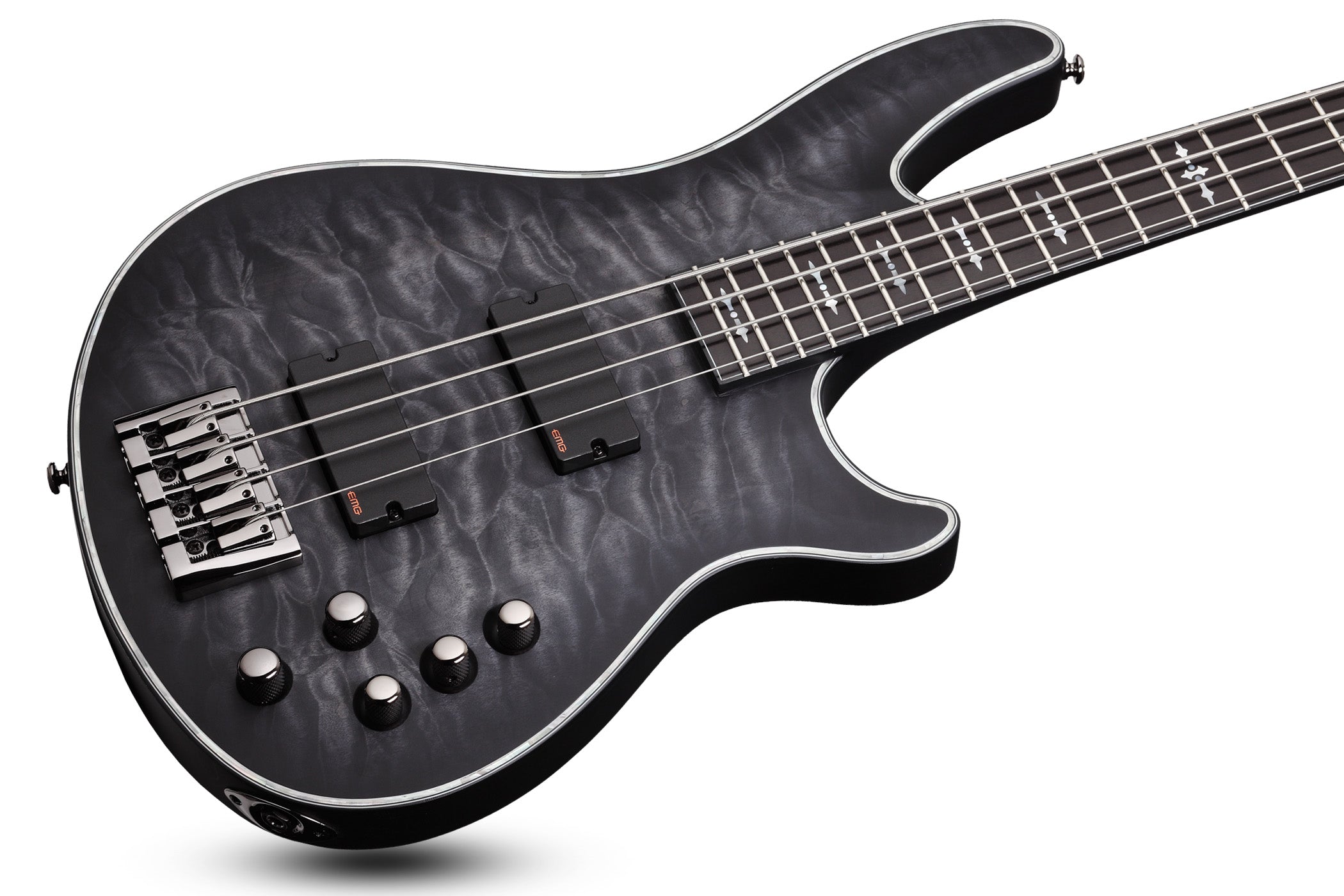Home>Instruments>Bass>What Bass Did Jason Newsted Use


Bass
What Bass Did Jason Newsted Use
Modified: January 27, 2024
Discover the bass that Jason Newsted used throughout his career. Explore his choice of bass instruments, techniques, and sound.
(Many of the links in this article redirect to a specific reviewed product. Your purchase of these products through affiliate links helps to generate commission for AudioLover.com, at no extra cost. Learn more)
Table of Contents
Introduction
When it comes to the world of bass guitar, one name that stands out is Jason Newsted. Known for his time as the bassist for the legendary heavy metal band Metallica, Newsted made a significant impact on the music industry with his powerful playing and energetic stage presence. In this article, we’ll delve into the world of Jason Newsted’s bass career, exploring his background, his time with Metallica, his signature basses, his gear setup, playing style, and his post-Metallica journey.
Born on March 4, 1963, in Battle Creek, Michigan, Jason Newsted showed an early interest in music and began playing bass guitar at a young age. He honed his skills and developed a unique style that set him apart from other bassists in the industry. With a passion for heavy metal and rock music, Newsted embarked on a journey that would lead him to become one of the most influential bassists of his time.
Join Jason Newsted on a journey through his fascinating bass career, from his early days to his time with Metallica and beyond. Discover the equipment he used, the basses he favored, and the techniques he employed to create that iconic heavy sound that fans know and love.
So, buckle up and get ready to dive into the world of Jason Newsted’s bass expertise. Whether you’re a die-hard Metallica fan or simply interested in learning more about the art of bass guitar, this article will take you on an exciting and informative ride.
Early Career and Background
Jason Newsted’s passion for music began at a young age. Growing up in a musically-inclined family, he started playing guitar and trumpet before eventually finding his calling with the bass guitar. Inspired by bands like Black Sabbath and Led Zeppelin, Newsted’s love for heavy metal and rock music fueled his desire to pursue a career in the industry.
In his teenage years, Newsted played in various local bands, performing at small venues and honing his skills as a bassist. It was during this time that he developed his powerful playing style, characterized by fast and aggressive bass lines. His dedication and talent quickly gained recognition within the local music scene.
At the age of 19, Newsted decided to make a significant career move and relocated to Phoenix, Arizona. This decision proved to be a pivotal moment in his life, as he joined the thrash metal band Flotsam and Jetsam in 1983. Newsted’s time with Flotsam and Jetsam allowed him to further refine his bass skills and gain valuable experience in the music industry.
Despite his success with Flotsam and Jetsam, Newsted had his sights set on something bigger. In 1986, he received a life-changing phone call from Metallica’s frontman, James Hetfield, inviting him to audition as the bassist for the band. Thrilled by the opportunity, Newsted auditions and ultimately impressed the members of Metallica with his exceptional talent and stage presence.
Newsted’s unique playing style and his ability to keep up with the fast-paced and intricate compositions of Metallica made him the perfect fit for the band. In 1987, he officially joined Metallica, marking the beginning of a new chapter in his career that would define him as one of the greatest bassists in rock history.
Joining Metallica
Joining Metallica was a significant turning point in Jason Newsted’s career. When he joined the band in 1987, Metallica was already at the forefront of the thrash metal movement, gaining massive popularity with albums like “Kill ‘Em All” and “Ride the Lightning.” Newsted stepped into the role of bassist following the tragic death of Metallica’s original bassist, Cliff Burton.
Adapting to his new role, Newsted faced the challenge of filling the shoes of a beloved and immensely talented bassist. However, he was determined to make his mark and contribute to Metallica’s evolving sound. The first album he recorded with the band was “…And Justice for All,” released in 1988. Though noted for its lack of bass presence in the mix, Newsted’s playing featured a level of intensity and technicality that captured the band’s relentless energy.
As the years went by, Newsted’s contributions to Metallica became increasingly pronounced. He showcased his skills on the bass guitar with intricate and melodic lines that complemented the band’s heavy sound. Whether it was the fast-paced “Dyers Eve,” the punchy groove of “Sad but True,” or the haunting melodies of “The God That Failed,” Newsted brought a dynamic and powerful presence to Metallica’s music.
Beyond his musical contributions, Newsted also played a vital role in the band’s songwriting process. He co-wrote several notable Metallica songs, including “The Struggle Within” from the self-titled album, known as the “Black Album.” His ideas and creativity added a fresh perspective to Metallica’s sound, further solidifying his place within the band.
Newsted’s time with Metallica also encompassed many memorable live performances. He brought an electrifying energy to the stage, commanding the attention of audiences with his headbanging and infectious enthusiasm. His bass solos, such as the iconic “My Friend of Misery” solo during live shows, highlighted his technical prowess and added an extra level of excitement to Metallica’s live performances.
While Jason Newsted’s tenure with Metallica was marked by immense success and accolades, his journey with the band also had its fair share of challenges and struggles. However, his contributions to Metallica’s music and his ability to seamlessly integrate into the band’s unique sound solidified his place as a legendary bassist in the history of rock and metal.
Jason Newsted’s Bass Equipment
Jason Newsted’s bass equipment played a crucial role in shaping his iconic sound during his time with Metallica and beyond. Known for his thunderous and heavy tones, Newsted utilized a variety of gear to achieve his unique bass sound.
One of the key components of Newsted’s bass setup was his choice of bass guitars. During his time with Metallica, he primarily played basses from the iconic brand, ESP. He favored models such as the ESP E-II Stream and the ESP DV8 signature bass. These instruments provided the durability, playability, and tone required for the intensity of Metallica’s music.
To amplify his bass sound on stage and in the studio, Newsted relied on a selection of bass amplifiers and speaker cabinets. One of his go-to amplifier choices was the Ampeg SVT-2 Pro, known for its warm and powerful tube-driven tone. Coupled with cabinets like the Ampeg SVT-810E, Newsted was able to produce a thick and punchy low-end that cut through the mix.
In addition to his bass guitar and amplifier setups, Newsted also experimented with a range of effects pedals to shape his bass tone. One notable pedal in his arsenal was the Electro-Harmonix Big Muff Pi, a fuzz distortion pedal that added grit and aggression to his sound. He also utilized effects like chorus and wah pedals to add depth and texture to certain sections of Metallica’s songs.
Besides his main bass setup, Newsted often incorporated acoustic bass guitars into his performances. This provided a contrasting sound and added a melodic element to Metallica’s music during moments of introspection. His preferred acoustic bass was the Alvarez AB60, known for its rich tone and playability.
It’s worth mentioning that Newsted’s gear choices evolved over the years, reflecting his musical growth and changing preferences. After departing from Metallica, he continued to experiment with different basses and equipment, exploring a wider sonic palette.
Overall, Jason Newsted’s bass equipment was a crucial component in creating his powerful and distinctive bass sound. His careful selection of bass guitars, amplifiers, and effects pedals, combined with his skillful playing, allowed him to carve out a sonic space that became synonymous with Metallica’s music.
Signature Basses
As a legendary bassist, Jason Newsted had the opportunity to collaborate with guitar manufacturers to create signature basses tailored to his playing style and preferences. These signature instruments not only showcased Newsted’s influence in the bass community but also provided bassists with the opportunity to achieve his unique tone and aesthetics.
One of the most notable signature basses associated with Jason Newsted is the ESP DV8. This bass was designed based on Newsted’s specifications and features, reflecting his heavy metal influence. With a sleek and aggressive design, the ESP DV8 boasted a mahogany body, a maple neck, and an ebony fingerboard. The bass was equipped with EMG active pickups and a three-band EQ, allowing for precise tonal control. The ESP DV8 became a popular choice among bassists looking to emulate Newsted’s powerful sound.
In addition to the ESP DV8, Newsted also collaborated with Spector basses to create the Spector Jason Newsted Signature Bass. This instrument featured a distinct body shape and design, with a solid alder body, a three-piece maple neck, and a rosewood fingerboard. Equipped with custom-designed EMG pickups and a Spector Tone Pump preamp, this signature bass delivered a punchy and aggressive tone that mirrored Newsted’s playing style.
Newsted’s signature basses not only focused on aesthetics and tonal capabilities but also featured design elements catered to his playing technique. For example, the ESP DV8 and Spector Signature Bass both incorporated extra-jumbo frets, allowing for easier string bending and fast playability. These design choices reflected Newsted’s preference for dynamic and energetic playing.
By collaborating with renowned guitar manufacturers, Jason Newsted’s signature basses became popular choices among bassists seeking to replicate his crushing and thunderous sound. These instruments not only paid tribute to Newsted’s impact on the bass world but also empowered aspiring bassists to explore their own creative potential.
While Newsted’s time with signature basses was most closely associated with his tenure in Metallica, his post-Metallica career also saw him explore different bass options, showcasing a versatile approach to his instrument of choice. From his signature models to an array of basses in his collection, Newsted’s passion for bass guitar and commitment to pushing boundaries continue to inspire bassists around the world.
Bass Gear and Setup
Jason Newsted’s bass gear and setup were crucial in achieving his distinctive tone and delivering powerful performances. Throughout his career, he utilized a combination of carefully selected equipment to create his signature sound.
Starting with his bass guitars, Newsted primarily played four-string instruments, which were a staple in the metal genre. Alongside his signature models, he also used other basses such as the Gibson Thunderbird and the Fender Precision Bass. These bass guitars offered a solid foundation and versatility, allowing Newsted to cover a wide range of musical styles within Metallica’s discography.
In terms of strings, Newsted favored medium gauge sets, typically with a roundwound construction. This choice provided a balanced mix of brightness and warmth, giving his bass lines clarity and definition. It also allowed him to achieve the necessary tension for his aggressive playing style and energetic performances.
When it came to amplification, Newsted relied on a combination of powerful bass heads and speaker cabinets to accommodate Metallica’s high-intensity live shows. His go-to amp was the Ampeg SVT-2 Pro, known for its rich tube-driven tone. Paired with a stack of Ampeg SVT-810E cabinets, he was able to deliver thunderous low-end frequencies that cut through the band’s dense guitar-driven sound.
In terms of effects pedals, Newsted used a modest setup to add textures and dynamics to his bass sound. He incorporated the iconic Electro-Harmonix Big Muff Pi fuzz pedal, which contributed to his aggressive and heavy tone. Additionally, he employed chorus and wah effects on certain songs to create depth and expression, enhancing the overall sonic palette of Metallica’s music.
Newsted’s playing style was characterized by fast and aggressive picking, fingerstyle techniques, and occasional use of slapping and popping. His right-hand attack, combined with his precise fretting hand technique, contributed to the intensity and drive in his bass lines. By using a pick or his fingers, he was able to execute intricate bass patterns while maintaining a powerful presence in Metallica’s sound.
During live performances, Newsted incorporated bass solos and extended improvisations, showcasing his technical ability and stage presence. These solos allowed him to demonstrate his nimble fingerwork and showmanship, captivating audiences around the world.
As with any professional musician, Newsted’s gear and setup evolved over the years to accommodate his changing musical preferences and technological advancements. However, his commitment to producing a heavy and aggressive bass sound remained constant, allowing him to leave a lasting impact on the world of bass guitar.
Playing Style and Techniques
Jason Newsted’s playing style and techniques were vital in defining his role as the bassist for Metallica and contributed to the band’s signature sound. Known for his energetic and powerful performances, Newsted utilized various techniques to create his unique bass lines.
One prominent aspect of Newsted’s playing style was his fierce picking technique. He frequently used a pick to attack the strings with precision and aggression, allowing him to produce fast and articulate bass lines. This technique added a level of intensity to Metallica’s music, especially during fast-paced songs like “Battery” and “Damage, Inc.”
In addition to picking, Newsted was also proficient in fingerstyle playing. Employing a combination of finger plucking and slapping techniques, he added a dynamic and percussive element to his bass lines. This approach could be heard in songs like “For Whom the Bell Tolls,” where his slapping technique created a distinctive and rhythmic sound.
To enhance his bass lines further, Newsted occasionally incorporated tapping and harmonics into his playing. These techniques granted him the ability to produce melodic and atmospheric effects. Examples of this can be found in songs like “Anesthesia (Pulling Teeth)” and “To Live Is to Die,” where he showcased his technical abilities with tap harmonics and melodic bass solos.
Newsted’s playing style also relied heavily on his sense of groove and timing. He had a keen sense of rhythm, allowing him to lock in tightly with Metallica’s drummer, Lars Ulrich. Together, they created a formidable rhythm section that formed the backbone of the band’s sound.
Another notable aspect of Newsted’s playing style was his use of octaves and power chords. These techniques added depth and a heavy texture to his bass lines, further driving Metallica’s hard-hitting sound. In songs like “Enter Sandman” and “Sad but True,” the use of octaves and power chords amplified the sonic impact and created a wall of sound.
Throughout his career, Jason Newsted’s playing style and techniques evolved and adapted to the ever-changing musical landscape. He continuously pushed the boundaries of what could be achieved on the bass guitar, incorporating new techniques and exploring different musical genres.
Not only did his playing style contribute to the success of Metallica, but it also left a lasting impact on aspiring bassists worldwide. Jason Newsted’s fierce and dynamic approach to the instrument continues to inspire and influence bass players, ensuring his legacy as one of the most influential bassists in the history of rock and metal music.
Departure from Metallica
After over a decade of being an integral part of Metallica’s lineup, Jason Newsted made the difficult decision to depart from the band in 2001. His departure marked the end of an era and left fans and fellow band members saddened by the news.
There were several factors that contributed to Newsted’s decision to leave Metallica. One of the primary reasons was the toll that constant touring and the pressures of being in a world-renowned band had taken on him both physically and mentally. The grueling schedule and intense scrutiny had begun to affect his well-being, prompting him to prioritize his personal health and happiness.
Additionally, Newsted expressed his desire to explore other musical opportunities and pursue his own artistic ventures. As a creative individual, he felt the need to challenge himself and expand his musical horizons beyond the confines of Metallica’s sound. Departing from the band gave him the freedom to explore new projects and collaborations.
Despite his departure, Newsted maintained an amicable relationship with his former bandmates. He continued to support Metallica and even appeared as a special guest during some of their performances in later years. The mutual respect and camaraderie between Newsted and the band remained intact, demonstrating the strong bond forged during their time together.
Following his departure from Metallica, Jason Newsted embarked on various musical endeavors. He formed the band Newsted, which released an album titled “Heavy Metal Music” in 2013. The album showcased Newsted’s versatility as a musician and received positive reviews from both fans and critics.
Moreover, Newsted explored other genres and collaborated with artists outside the realm of heavy metal. His venture into different musical styles allowed him to push his creative boundaries and showcase his versatility as a bassist and songwriter.
While Jason Newsted’s departure from Metallica marked the end of a chapter, it also marked the beginning of a new phase in his musical career. His departure allowed him the opportunity to explore his own musical endeavors, solidifying his legacy as a talented and respected musician.
Despite his departure, Newsted’s contributions to Metallica’s music and his impact as a bassist continue to be celebrated and recognized by fans and musicians worldwide. His time with the band will forever remain an important chapter in the history of Metallica, etching his name alongside other legendary bassists who have left an indelible mark on the music industry.
Post-Metallica Career
Following his departure from Metallica, Jason Newsted embarked on a diverse and dynamic post-Metallica career that showcased his versatility as a musician. He actively pursued various musical projects and collaborations, solidifying his status as a respected bassist and artist.
One of Newsted’s notable endeavors was the formation of his own band, simply named Newsted. The band released their debut album, “Heavy Metal Music,” in 2013. The album showcased Newsted’s range as a songwriter and featured hard-hitting tracks that resonated with audiences. With songs like “Soldierhead” and “Above All,” Newsted demonstrated his ability to create powerful and compelling music beyond his Metallica days.
Throughout his post-Metallica career, Newsted collaborated with a range of artists from different genres, further expanding his artistic repertoire. He joined forces with bands like Voivod, playing bass and contributing to their albums and live performances. This collaboration allowed him to infuse his heavy bass style into the progressive and avant-garde sound of Voivod, creating a unique fusion of musical elements.
In addition to his work with other bands, Newsted pursued solo projects and released music under his own name. He ventured into acoustic and more introspective sounds, showcasing his ability to adapt to different musical styles. His solo work demonstrated his versatility as a musician and highlighted his knack for crafting immersive and emotive compositions.
Beyond music, Newsted also explored visual arts and expressed his creativity through paintings and mixed media artworks. This multidimensional approach to artistic expression showcased his diverse talents and served as another outlet for his creativity and personal growth.
Newsted’s post-Metallica career highlighted his commitment to pushing boundaries and continuously evolving as an artist. Whether delving into heavy metal, collaborating with other musicians, or exploring new artistic mediums, he remained dedicated to his craft and continued to inspire fellow musicians and fans alike.
While Newsted’s time with Metallica undoubtedly left an indelible mark on his career, his post-Metallica journey allowed him to carve out his own identity and establish himself as a respected musician beyond the iconic band. His versatility, energy, and passion for music have secured his place in the annals of rock and metal history.
As he continues to create, collaborate, and explore new avenues, Jason Newsted’s post-Metallica career serves as a testament to his enduring influence and his unwavering dedication to his craft.
Conclusion
Jason Newsted’s career as a bassist has left an indelible mark on the world of rock and heavy metal music. From his time with Metallica to his post-Metallica endeavors, Newsted’s influence and impact continue to resonate with fans and fellow musicians.
His dynamic and energetic bass playing, characterized by aggressive picking, intricate fingerstyle techniques, and powerful stage presence, helped shape Metallica’s sound and contribute to their success. Newsted’s ability to craft thunderous and melodic bass lines added a layer of intensity and depth to the band’s music, solidifying his place as one of the greatest bassists in the genre.
Throughout his career, Newsted explored various musical avenues, collaborating with artists and bands from different genres. This artistic versatility showcased his ability to adapt and innovate, proving that his talent extended beyond the confines of metal music. His solo projects and collaborations demonstrated his range as a musician and allowed him to express different facets of his artistic identity.
Beyond his musical contributions, Jason Newsted’s departure from Metallica and his subsequent career path showcased his resilience, independence, and commitment to artistic growth. He took the opportunity to explore new musical horizons and pursue his own creative endeavors, earning the respect and admiration of fans and peers.
While his time with Metallica defined a significant part of his legacy, Jason Newsted’s post-Metallica journey ensures that his name will forever be etched in the tapestry of rock history. His influential bass sound, his dynamic playing style, and his unwavering passion for music continue to inspire generations of bassists and musicians.
In conclusion, Jason Newsted’s remarkable bass career is a testament to the power of talent, dedication, and artistic exploration. His contributions to Metallica’s music and his ongoing pursuit of musical innovation have solidified his status as an icon in the realm of bass guitar. Whether he’s thrashing on stage, engaging in collaborative projects, or embracing new artistic endeavors, Jason Newsted remains a force to be reckoned with in the world of heavy music.











